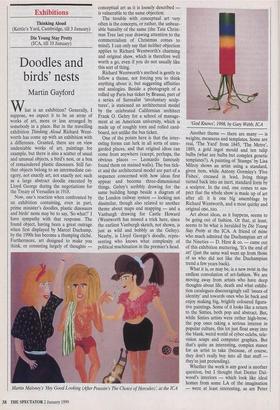Exhibitions
Thinking Aloud (Kettle's Yard, Cambridge, till 3 January) Die Young Stay Pretty (ICA, till 10 January)
Doodles and birds' nests
Martin Gayford
What is an exhibition? Generally, I suppose, we expect it to be an array of works of art, more or less arranged by somebody in a place. But in the travelling exhibition Thinking Aloud Richard Went- worth has come up with an exhibition with a difference. Granted, there are on view undeniable works of art, paintings for example, but there is also a scatter of usual and unusual objects, a bird's nest, or a box of remaindered plastic dinosaurs. Still fur- ther objects belong to an intermediate cat- egory, not exactly art, not exactly not: such as a large abstract doodle executed by Lloyd George during the negotiations for the Treaty of Versailles in 1918.
Now, one's reaction when confronted by an exhibition containing, even in part, prime minister's doodles, plastic dinosaurs and birds' nests may be to say, 'So what?' I have sympathy with that response. The found object, having been a great outrage when first displayed by Marcel Duchamp, by the 1990s has become a thumping cliché. Furthermore, art designed to make you think, or consisting largely of thoughts — conceptual art as it is loosely described is vulnerable to the same objection.
The trouble with , conceptual art very often is the concepts, or rather, the unbear- able banality of the same (the Tate Christ- mas Tree last year drawing attention to the commercialism of Christmas comes to mind). I can only say that neither objection applies to Richard Wentworth's charming and original show, which is therefore well worth a go, even if you do not usually like this sort of thing.
Richard Wentworth's method is gently to follow a theme, not forcing you to think anything about it, but suggesting affinities and analogies. Beside a photograph of a rolled up Paris bus ticket by Brassai, part of a series of Surrealist 'involuntary sculp- tures', is stationed an architectural model by the celebrated Californian architect Frank 0. Gehry for a school of manage- ment at an American university, which is made up of roughly torn and rolled card- board, not unlike the bus ticket.
One of the points here is that the inter- esting forms can lurk in all sorts of unre- garded places, and that original ideas can come from anywhere (except, perhaps, the obvious places — Leonardo famously found them on stained walls). The bus tick- et and the architectural model are part of a sequence concerned with how ideas first appear and become three-dimensional things. Gehry's scribbly drawing for the same building hangs beside a diagram of the London railway system — looking not dissimilar, though also related to another theme about maps and mapping — and a Vanburgh drawing for Castle Howard (Wentworth has missed a trick here, since the earliest Vanburgh sketch, not shown, is just as wild and bobbly as the Gehry). Nearby, is Lloyd George's doodle, repre- senting who knows what complexity of political machination in the premier's head.
Martin Maloney's 'Hey Good Looking (After Poussin's The Choice of Hercules); at the ICA 'God Knows, 1998, by Gary Webb, ICA Another theme — there are many — is weights, measures and templates. Some are real, 'The Yard' from 1845, 'The Metre', 1889, a gold ingot mould and ten tulip bulbs (what are bulbs but complex genetic templates?). A painting of 'Stamps' by Lisa Milroy shows an artist using a standard, given item, while Antony Gormley's 'Five Fishes', encased in lead, living things turned back into an inert, standard form by a sculptor. In the end, one comes to sus- pect that the whole show is made up of art after all: it is one big assemblage by Richard Wentworth, and a most quirky and original one, too.
Art about ideas, as it happens, seems to be going out of fashion. Or that, at least, seems to be what is heralded by Die Young Stay Pretty at the ICA. A friend of mine who much admired the Duchampian art of the Nineties — D. Hirst & co. — came out of this exhibition muttering, 'It's the end of art' (just the same wail went up from those of us who did not like the Duchampian trend a few years back).
What it is, or may be, is a new twist in the endless convolution of art-fashion. We are moving away from artists who have deep thoughts about life, death and what exhibi- tion catalogues discouragingly call 'issues of identity' and towards ones who lie back and enjoy making big, brightly coloured figura- tive paintings. Some of it looks like a return to the Sixties, both pop and abstract. But, while Sixties artists were rather high-brow, the pop ones taking a serious interest in popular culture, this lot just float away into the blank, weird world of cyber-celebs, tele- vision soaps and computer graphics. But that's quite an interesting, complex stance for an artist to take (because, of course, they don't really buy into all that stuff they're just pretending).
Whether the work is any good is another question, but I thought that Dexter Dal- wood's interiors — which look like ideal homes from some LA of the imagination — were at least interesting, as are Peter Davies's wonky abstracts and the work of Martin Malony, curator of the show. The fact that so many people don't like what they're doing suggests these artists may be on to something.
Thinking Aloud travels to the Cornerhouse, Manchester, from 9 January to 23 February, and then Camden Arts Centre from 9 April to 30 May.



























































 Previous page
Previous page